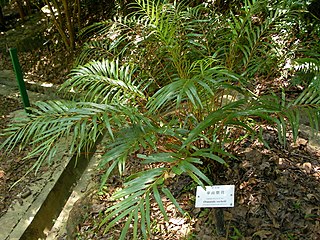
Osmundaceae is a family of ferns containing four to six extant genera and 18–25 known species. It is the only living family of the order Osmundales in the class Polypodiopsida (ferns) or in some classifications the only order in the class Osmundopsida. This is an ancient and fairly isolated group that is often known as the "flowering ferns" because of the striking aspect of the ripe sporangia in Claytosmunda, Osmunda, Osmundastrum, and Plensium. In these genera the sporangia are borne naked on non-laminar pinnules, while Todea and Leptopteris bear sporangia naked on laminar pinnules. Ferns in this family are larger than most other ferns.

Fiddleheads or fiddlehead greens are the furled fronds of a young fern, harvested for use as a vegetable.

Osmunda is a genus of primarily temperate-zone ferns of family Osmundaceae. Five to ten species have been listed for this genus.

Claytosmunda is a genus of fern. It has only one extant species, Claytosmunda claytoniana, the interrupted fern, native to Eastern Asia, Eastern United States, and Eastern Canada.

Osmunda regalis, or royal fern, is a species of deciduous fern, native to Europe, Africa and Asia, growing in woodland bogs and on the banks of streams. The species is sometimes known as flowering fern due to the appearance of its fertile fronds.
The Wanda Mountains are located in the Heilongjiang Province of China.

Osmundastrum is genus of leptosporangiate ferns in the family Osmundaceae with one living species, Osmundastrum cinnamomeum, the cinnamon fern. It is native to the Americas and eastern Asia, growing in swamps, bogs and moist woodlands.

Osmunda japonica, also called Asian royal fern, is a fern in the genus Osmunda native to east Asia, including Japan, China, Korea, Taiwan, and the far east of Russia on Sakhalin. It is called gobi (고비) in Korean and zenmai in Japanese.
Royal fern or Royal Fern may refer to:
Osmunda × mildei is a rare fern, known only from a few locations in the area of Hong Kong. It is also a rarity in that it appears to be a species of hybrid origin within the Osmundaceae. Its putative parents are Osmunda japonica and Plenasium vachellii or P. angustifolium.

Osmunda spectabilis, known as American royal fern, is a species of fern native to a large area of the New World, from the eastern half of Canada and the United States to Argentina.

Plenasium vachellii is a fern in the family Osmundaceae. The genus Plenasium is recognized in the Pteridophyte Phylogeny Group classification of 2016 (PPG I); however, some sources place all Plenasium species in a more broadly defined Osmunda, treating this species as Osmunda vachellii. It is native to south-central and southeast China and Indochina.
Osmunda lancea is a fern in the genus Osmunda, section Euosmunda. It is found in Japan.
Plenasium angustifolium is a fern in the family Osmundaceae. The genus Plenasium is recognized in the Pteridophyte Phylogeny Group classification of 2016 (PPG I); however, some sources place all Plenasium species in a more broadly defined Osmunda, treating this species as Osmunda angustifolia. It is native to eastern Thailand, Laos and southern China, and has been introduced into India and Sri Lanka.

Plenasium banksiifolium is a fern in the family Osmundaceae. The genus Plenasium is recognized in the Pteridophyte Phylogeny Group classification of 2016 (PPG I); however, some sources place all Plenasium species in a more broadly defined Osmunda, treating this species as Osmunda banksiifolia. It is native along the Pacific coast of Asia, being found in the Kamchatka Peninsula, the Ryukyu Islands, Japan, southeast China, Taiwan, the Philippines, Borneo, Sulawesi and Java. P. banksiifolium, which can reach a height of 1.5 m, is the largest species in the genus and has ornamental value.
Plenasium javanicum is a fern in the family Osmundaceae. The genus Plenasium is recognized in the Pteridophyte Phylogeny Group classification of 2016 (PPG I); however, some sources place all Plenasium species in a more broadly defined Osmunda, treating this species as Osmunda javanica. It has a wide native distribution in south-eastern Asia, being found in the Eastern Himalaya, south-central and south east China, Indochina, the Philippines, Borneo, Sumatra, Sulawesi and Java.
Osmunda vancouverensis is an extinct species of Osmunda ferns. The name is used to refer to permineralized fertile frond segments found in the Lower Cretaceous of British Columbia.
Osmunda greenlandica is an extinct species of ferns in the genus Osmunda.
Osmunda × ruggii is a sterile hybrid between Osmundastrum claytonianum and Osmunda regalis var. spectabilis.







